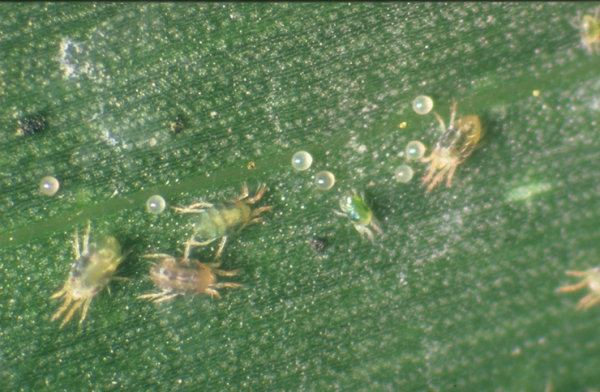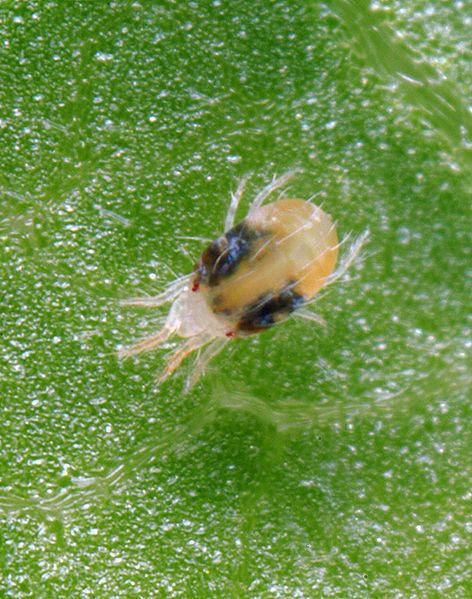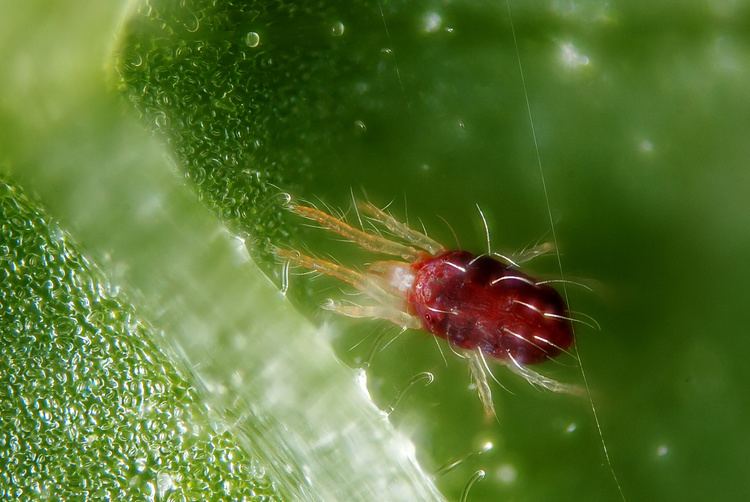Rank Species Subclass Acari | Scientific name Tetranychus urticae Higher classification Tetranychus | |
 | ||
Similar Tetranychus, Whitefly, Thrips, Predatory mite, Aphid | ||
Red spider mite tetranychus urticae vs phytoseiulus persimilis
Tetranychus urticae (common names include red spider mite and two-spotted spider mite) is a species of plant-feeding mite generally considered to be a pest. It is the most widely known member of the family Tetranychidae or spider mites. Its genome was fully sequenced in 2011, and was the first genome sequence from any chelicerate.
Contents
- Red spider mite tetranychus urticae vs phytoseiulus persimilis
- Tetranychus urticae ciclo de vida
- Distribution
- Description
- Ecology
- Lifecycle
- Inbreeding avoidance
- Genomics
- References

Tetranychus urticae ciclo de vida
Distribution
T. urticae was originally native only to Eurasia, but has acquired a cosmopolitan distribution.
Description

T. urticae is extremely small, barely visible with the naked eye as reddish or greenish spots on leaves and stems; the adult females measure about 0.4 mm long. The red spider mite, which can be seen in greenhouses and tropical and temperate zones, spins a fine web on and under leaves.
Ecology

This spider mite is extremely polyphagous; it can feed on hundreds of plants, including most vegetables and food crops – such as peppers, tomatoes, potatoes, beans, maize, and strawberries, and ornamental plants such as roses. It is the most prevalent pest of Withania somnifera in India. It lays its eggs on the leaves, and it poses a threat to host plants by sucking cell contents from the leaves cell by cell, leaving tiny pale spots or scars where the green epidermal cells have been destroyed. Although the individual lesions are very small, attack by hundreds or thousands of spider mites can cause thousands of lesions, thus can significantly reduce the photosynthetic capability of plants.
The mite's natural predator, Phytoseiulus persimilis, commonly used as a biological control method, is one of many predatory mites which prey mainly or exclusively on spider mites.
Other than certain aphids, T. urticae is the only animal known to be able to synthesise carotenoids. As in aphids, the genes for carotene synthesis appear to have been acquired through horizontal gene transfer from a fungus.
Lifecycle
T. urticae reproduces through arrhenotoky, a form of parthenogenesis in which unfertilized eggs develop into males.
The egg of T. urticae is translucent and pearl-like. It hatches into a larva, and two nymph stages follow: a protonymph, and then a deutonymph, which may display quiescent stages. The adults are typically pale green for most of the year, but later generations are red; mated females survive the winter in diapause.
Inbreeding avoidance
Inbreeding is detrimental for fitness in T. urticae. Inbred progeny mature more slowly than outbred progeny, and inbred female progeny have lower reproductive output. T. urticae females apparently can recognize kin and have the ability to avoid inbreeding through mate choice.
Genomics
The genome of T. urticae was fully sequenced in 2011, and was the first genome sequence from any chelicerate.
